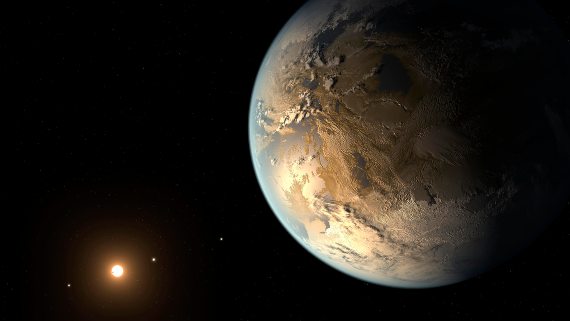A large part of humanity is convinced that the universe is a place teeming with life, including technological civilisations. This is paradoxical, considering that we lack the slightest evidence of this; we have not even been able to explain how life arose on our own planet. But many have embraced a simple idea: the Copernican principle that the Earth is not a privileged place in the universe. And if life and humans have emerged on one planet, in one solar system and in one galaxy that have nothing unique or extraordinary about them, why not elsewhere?
And yet, our hunt for extraterrestrial life has thus far not found any conclusive evidence. Sky surveys that listen for traces of technosignatures, signs of alien technology, have reaped only silence and darkness. The latest of these has just been published. Astronomers Chenoa Tremblay and Steven Tingay of the International Centre for Radio Astronomy Research (ICRAR) have used the Australian Murchison Widefield Array radio telescope to survey the region around the constellation of Vela, which comprises some 10 million stars. “No unknown signals were found,” the study concludes.
However, Tingay stresses that, so far, SETI (Search for Extraterrestrial Intelligence) projects have only examined the equivalent of the volume of a swimming pool compared to the entirety of the Earth’s oceans: “Even though we made a factor of 100 improvement on past results, the swimming pool out of the ocean analogy holds,” he tells OpenMind. The astronomer quotes a recent estimate that there could be as many as 36 civilisations in our galaxy, or between 4 and 211, “which means they are few and far between,” he concludes. “We would have to be very lucky to have one of those stellar systems in the search volume that we reported in our paper.”
How many civilisations capable of communicating might exist in the galaxy?
This estimate is the work of University of Nottingham astronomers Tom Westby and Christopher Conselice, who have tackled an old question: how many civilisations capable of communicating across space might exist in the galaxy? Traditionally, speculation has revolved around the equation formulated by Frank Drake in 1961. However, its uncertainties are such that solutions have been proposed ranging from zero to billions. Conselice and Westby have based their work on the astrobiological version of the Copernican principle, according to which intelligent life could emerge on other planets as it has on Earth. “If the right conditions in the universe are met, similar to how we formed, then scientifically there is no reason that something similar could not also happen,” Conselice told OpenMind. For the astronomer, the reason we haven’t encountered anyone yet is that the nearest civilisation would be some 17,000 light years away. “SETI so far has only gone a few tens of light-years,” he says. “The volume of the galaxy searched is very, very tiny.”

Conselice and Westby are not alone in suggesting that intelligent life comparable to humans is not as ubiquitous as is commonly believed. Using an improved variant of the Bayesian inference, a type of statistical analysis that incorporates observations to refine its estimates, Columbia University astronomer David Kipping has analysed what might happen on Earth if the tape of the planet’s history were rewound and played back over and over again, as in the famous mental experiment proposed in 1989 by palaeontologist Stephen Jay Gould. He argued that, in a million repetitions, humans would not emerge again.
Kipping’s results give a 3 to 1 probability that abiogenesis, the emergence of life, is a common and early phenomenon. “So if we re-ran the tape we would expect abiogenesis to repeat,” he sums up to OpenMind. By contrast, it is rather unlikely that a human-like species would emerge again, although the analysis cannot quantify how rare intelligent life is: “1 in 100 is rare, but so is 1 in 10100. The latter would imply no-one else out there, the former would mean there could be civilizations peppered across the stars,” he explains.
The fallacy of the planet of the apes
At the Australian National University, Charles Lineweaver has also been studying the probability of life being a common phenomenon, and warns against the widespread idea that abiogenesis must inevitably lead to the development of what astronomer Carl Sagan called “the functional equivalent of humans”; Lineweaver calls it “the fallacy of the planet of the apes.” According to this scientist, there are bottlenecks in the planetary evolution that can divert biological evolution to a dead end. Until 100 million years ago, Australia shared similar species with other land masses, but its separation made it an isolated continent that did not give birth to the functional equivalent of humans. If Australia had been the only dry land on the planet, we wouldn’t be here.

But not only is the evolution of an intelligent technological species far from being a necessary consequence of abiogenesis, the emergence of life is not necessarily inevitable either. “We cannot be confident that abiogenesis is a common occurrence. That shouldn’t be the message you get from Kipping’s paper or from my paper.” The scientist points out that there are still many unknowns: we don’t know to what extent the bombardment of the Earth by asteroids in its early stages may have been involved in the origin of life, nor have we been able to produce life in the laboratory. Furthermore, he adds, “we have not been able to identify new life emerging on Earth; if life emerged on Earth some four billion years ago, why couldn’t it be emerging today on Earth under similar conditions?”
Second genesis
This argument is known as “second genesis”: how can we be confident that abiogenesis is common, if on Earth, as far as we know, it has only happened once? At NASA’s Ames Research Center, astrobiologist Alfonso Dávila is engaged in the search for a second genesis in the Solar System, analysing terrestrial sites similar to those on other worlds. For Dávila, it is possible that the Earth has given birth to multiple abiogenesis, but they have not thrived: “It is possible that evolutionary pressures (competition) will only allow one global biochemistry per planet to triumph; ‘there can be only one’, for the fans of Highlander,” he says. According to the astrobiologist, even the discovery of life on another world in the Solar System would not be proof of a second genesis, as its origin could be the same as that of life on Earth: “The planets can exchange biological material, for example through meteorites. Personally, I don’t think it’s going to be easy to find evidence of a second genesis of life,” he adds.

Perhaps some answers to all of the above might be found in cyanobacteria. These photosynthetic microbes are among the first living beings on the planet that we know of, and their contribution was key to making the early Earth habitable. This is the field of research of biologist Patricia Sánchez-Baracaldo at the University of Bristol. “At some point, cyanobacteria started colonising the oceans, fixing unprecedented amounts of carbon and nitrogen. This was the fundamental leap and one that transformed life on Earth – and at this point we have the proliferation of complex life,” she summarises to OpenMind. Knowledge of this essential node of life on Earth can provide insights into what might happen elsewhere in the universe. And for Sánchez-Baracaldo, this is the verdict: “It is very likely that life has evolved on other planets if the right conditions are present.”
In short, answers are still lacking. “We’re doing the best we can to try to answer the question: How common is life in the universe?” says Lineweaver. “But I can confidently say that, as of yet, we have no confident conclusions.”
Javier Yanes
@yanes68
Comments on this publication